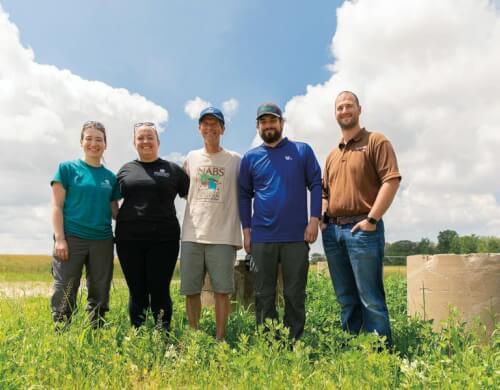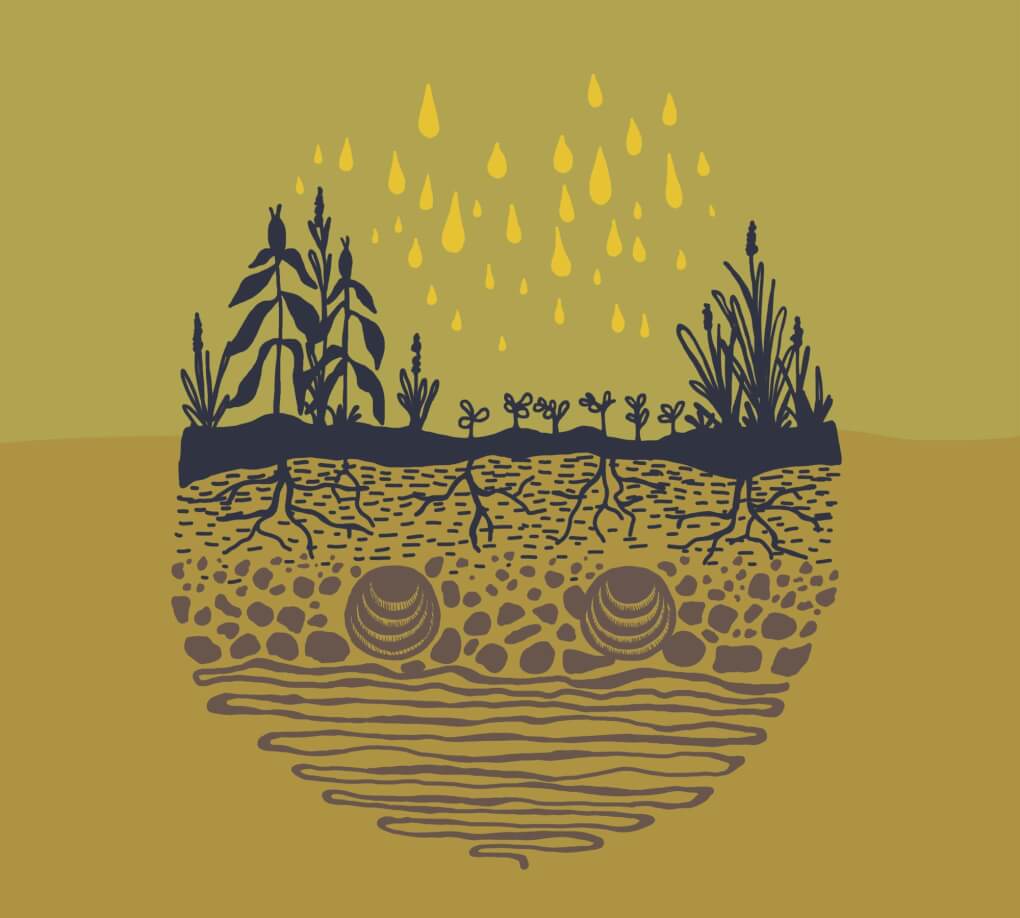On a quiet stretch of a West Michigan county road, Grand Valley researchers are leading an effort to mitigate the impact of the farm’s fertilizer runoff on local waterways.
The research, led by Alan Steinman, the Allen and Helen Hunting director of the Annis Water Resources Institute, aims to use a byproduct of steel manufacturing to help trap phosphorus that would otherwise enter into waterways, increasing the likelihood of problematic, and potentially toxic, algae blooms.
The project involves a partnership with Dykhuis Farms; Joel Dykhuis, president of family-run Dykhuis Farms, owns roughly 4,000 acres near Holland to grow corn, soybeans and wheat for his hogs, and Project Clarity, a community organization led by the Outdoor Discovery Center, which is dedicated to improving the water quality of Lake Macatawa in Holland.
The goal of the research, the first of this kind to be conducted in Michigan, is to determine if large, septic-tank-sized pits full of slag — an industrial byproduct of the steel-making process — can effectively serve as a filter for field runoff, catching excess phosphorus before water sends extra nutrients to streams, rivers and lakes, where it could cause algae blooms.
The process starts with an agricultural practice called tiling, in which farmers like Dykhuis bury perforated pipes under their fields to speed up drainage.
“The drainage tiles run through the field about every 40 feet, and it helps drain the water effectively,” Dykhuis said.
“In years with a spring like this one where it rained almost every day, it means we’re actually able to get out and do field operations much sooner. You save crops from drowning, so it’s really a core component of what we’re trying to do here.”

In the past, discharge from drain tiles flowed in one central pipe, then into drainage ditches on the edges of fields. From the ditches, water could flow unchecked into nearby creeks, rivers and lakes. If a heavy rain followed a fertilizer or manure application, ditch water would be rich with excess phosphorus and other excess nutrients.
Steinman said the basics of the research are simple: test the water to determine the phosphorus level before it goes into the slag filter pits, and test it as it comes out the other side to see how much phosphorus has been filtered out.
While the concept seems simple, the application could be significant. The project has received a grant from the Michigan Department of Agriculture and Rural Development, which is interested to see if there are positive reductions in the phosphorus load that could be replicated in other areas with high levels of available phosphorus.
Steinman and his technicians are also testing to see if the water coming from the filter contains any heavy metals, which would indicate a possible risk given that a steel byproduct is being used as a filter.
The goal of reducing excess phosphorus is important to the watershed, according to Dan Callum, the Macatawa Greenway Manager for Project Clarity, but the goal isn’t to remove all of it. Steinman said that hitting the right balance is critical.
“We still want things to grow— we don’t want a swimming pool — but we need to get it down from historically high levels,” Steinman said.
“I put my boat in Lake Mac and nobody wants a dirty lake. So this is a way we can preserve our community while minimizing our impact.”
Joel Dykhuis, president of family-run Dykhuis Farms
The project is a win for Dykhuis, and he said other farmers would agree.
“We believe we are stewards of the land. It’s part of our farm’s mission statement, to reduce our impact,” Dykhuis said. “There’s also economics. If the nutrients we’re putting down are leaving the farm through the necessity of tile drains, that means at some point we’re going to replace those nutrients. There’s a cost to that. So we really want to keep the land and the nutrients in place.”
Dykhuis also said the project is a win for the community.
“My family and all of our 170 employees live and work in this community, and I love to get out on the boat as well,” Dykhuis said. “I put my boat in Lake Mac and nobody wants a dirty lake. So this is a way we can preserve our community while minimizing our impact.”
The research is one aspect of the larger-scale Project Clarity, which has put more than 130 different projects in place in the past five years to improve the quality of lake water.
“Results have been good. The lake itself has numbers that are encouraging, but there is work left to be done,” Callum said. “Anecdotally, there are areas that are improving. Long-term, I’m confident we’ll see significant improvements to the health of the lake.”
Steinman said that if early results are positive, further testing will be done to see how the slag can be removed and recharged, meaning removing the phosphorus so the slag can be used again. Another possibility could be using the spent slag filters in whole form as a phosphorus-rich fertilizer in certain areas.
“This research is an innovative way to fix a widespread problem with benefits to everyone involved in a real-world, practical application,” Steinman said. “It’s a great way to reduce the amount of phosphorus before it goes straight into the ditches.
“Not only could this be done on Macatawa, but this could be done in hot spots statewide.”







